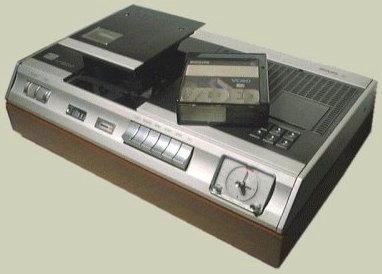 | |
 | |
 | |
 | |
 | ||||||
| ||||||
 |  | |||||
 | FORMAT: VCR | |||||
| DATE: 1972 PRICE: £442 [2005: £4000] 56x34x15cm | ||||||
 |  |
|
| ||||||||||||||||||||||||||||||
| There are three things which are necessary to allow a VCR to be used in the home: a tuner (to recieve TV signals directly from an aerial), a modulator (which allows the machine to play on a normal TV set) and a timer (to make recordings while you're out). The Philips N1500 was the first to have all three, and was therefore the first true home video machine. The brushed aluminium and wood-grain case is very attractive, even by modern standards, and although the wood-grain is fake, underneath there is "real" chipboard, making this the only home VCR to be made even partly of wood. The normal tape-recorder controls - play, stop, eject etc - are on the sloping front, along with the rotary tracking and audio level knobs, the counter and audio level meter, and the timer clock. The six TV channel selector buttons are on the top of the machine, along with other more arcane controls - including a colour-killer, which switched off the machine's colour circuits to improve the picture on a black-and-white television. | |
| The timer clock, uniquely, is an electro-mechanical analogue affair, very similar to the timers more normally found on electric cookers. It can be set to record for up to one hour, starting within 24 hours. The timer just turns the power on and off; you had to leave the machine with the record and play keys pushed in, so that it started recording when it came on. The timer was accurate to plus or minus two minutes, which is not very impressive by modern standards! |  |
It's Hip To Be Square... | |
 | Unlike modern video cassettes, the two spools in a VCR cassette were stacked one on top of the other, and the tape ran diagonally down the front. A flap at the front of the cassette, and a sliding door at the side, allowed the mechanism to access the tape. The VCR cassette |
| When the N1500 was launched, it could record for up to 45 minutes, though hour-long tapes were soon available. They were expensive, £14.50 per hour - four times the price of reel-to-reel video tape, and a staggering £90 in 2002 prices! | |
 | Internally, the machine is logically laid out with all the key components grouped into modules. There are no I.C.s ("chips"); all the electronics are discrete. The tape transport mechanism is driven by a large single motor (upper right), which has its own cooling fan built in. The operating keys are entirely mechanical, and work the mechanism directly. The capstan and head drum motor speeds were servo-controlled, which was remarkably sophisticated for the time. |
| As we have seen, one of the problems which must be solved on a cassette video recorder is how to lace up the tape when the ends are not accessible to the machine. The solution found by Philips is elegant and simple: | |
| The 105mm head drum, visible at upper left above, is mounted off-centre on a rotating platform. When the machine is switched on, this platform rotates, pulling the tape out and around the drum at the same time that the head moves towards the tape. The head drum ends up partly inside the cassette, while the tape is wrapped just over half way around the drum, as required for helical scanning. |  |
| In this system, the tape laces as soon as the power is turned on, and to un-lace, the machine must be switched off. The tape remains laced for all tape transport functions, including fast forward and rewind. | |
| Although the N1500 was a remarkable machine for its time - and a huge leap from the professional / industrial machines it was competing with - it gained a reputation for fragility. The recording heads, in particular, were a cause for concern, as they were only guaranteed for 50 hours use (though this was later upgraded to 1000 hours). Users (mainly schools / colleges and industry) also found recording to be somewhat "hit or miss", though this could be an early manifestation of the techno-fear which plagues home video - particularly programming timed recordings - even today. | |
| The original N1500 was followed by an upgraded N1501, which had some improvements to the colour circuitry and added a Still Motion (freeze frame) switch. With this was engaged, the picture stayed on the screen when STOP was pressed - there was no separate PAUSE button. Externally it was identical, apart from a rather severe black and dark-brown case. N1501 |  |
 | There were also two studio models, with no TV tuner or timer - direct A/V connections would be used instead. The N1460 was a cut-down N1500, while the N1520 was a full edit deck, with four heads, stereo sound, assemble & insert editing and audio dubbing. N1460 |